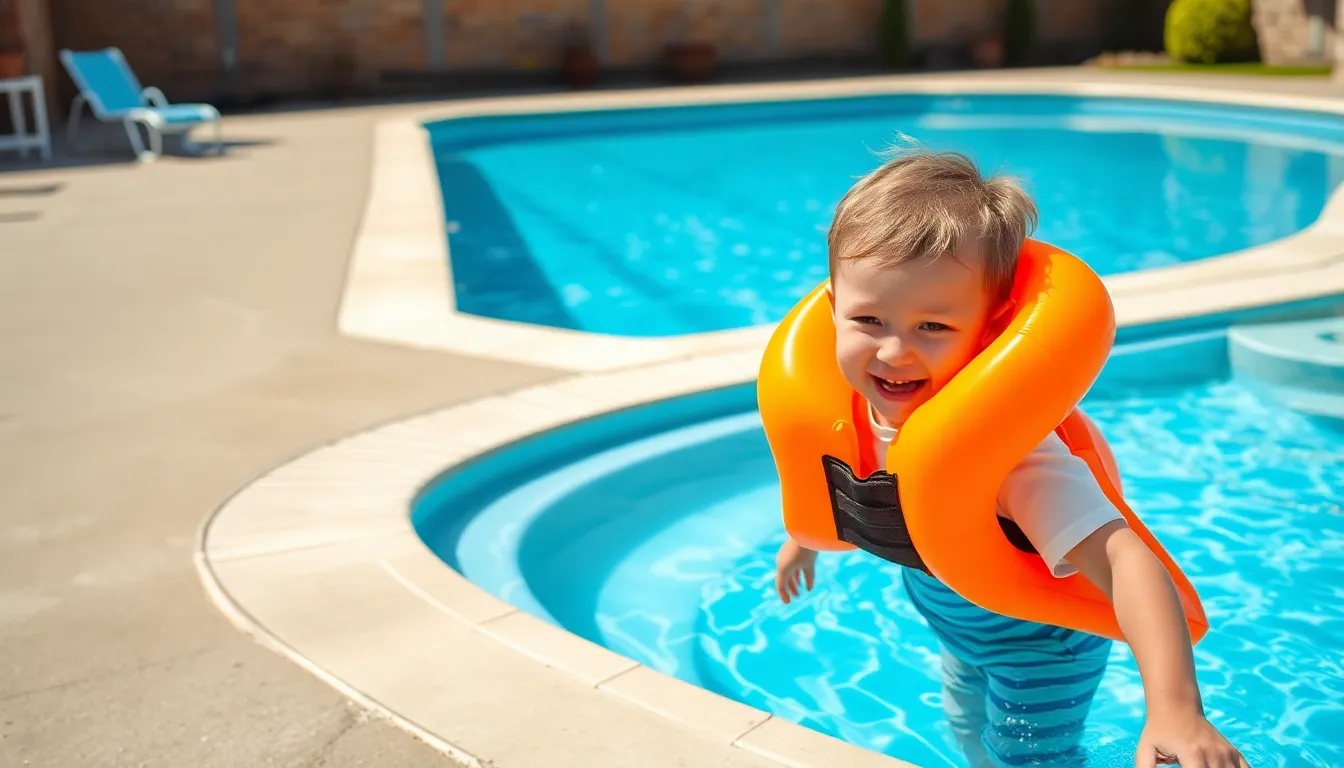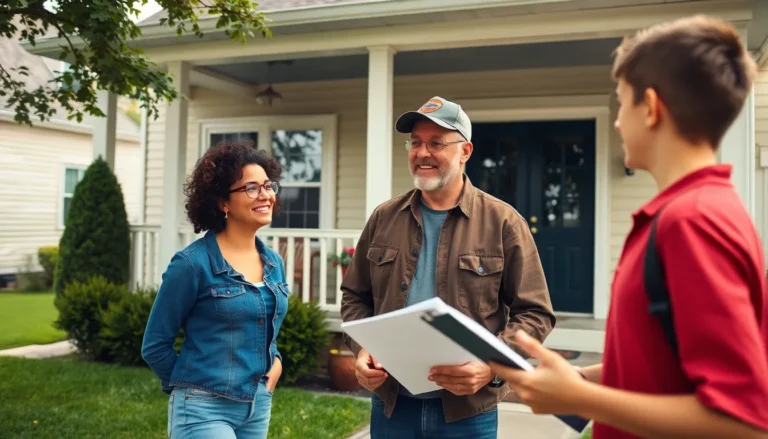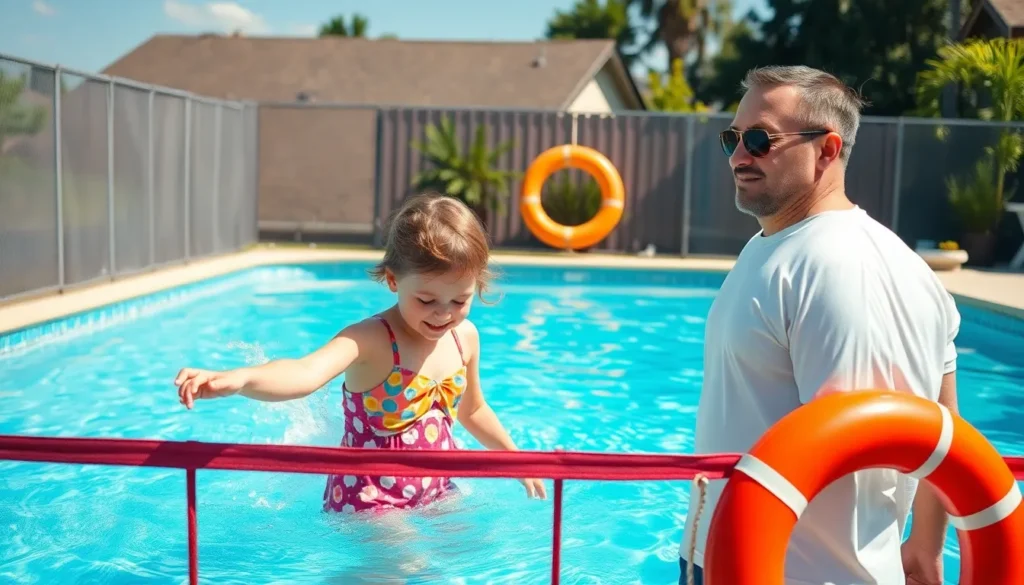Table of Contents
ToggleSummer’s just around the corner, and that means one thing: it’s time to dive into the refreshing waters of your backyard pool. But before cannonballing into fun, let’s chat about swimming pool safety. After all, no one wants their pool party to turn into a scene from a slapstick comedy where the only splash is a trip to the ER.
Importance of Swimming Pool Safety
Swimming pool safety plays a critical role in preventing accidents and ensuring a pleasant experience for everyone. Immediate access to safety equipment, such as life rings and first aid kits, enhances preparedness for emergencies. Awareness of potential dangers, like slippery surfaces and deep water, reduces risks for swimmers, especially children.
Effective supervision is essential when children are in or near the pool. Constant monitoring by an adult significantly decreases the chances of accidents, promoting a secure environment. Installing barriers, such as fences with self-locking gates, provides an additional layer of protection against unauthorized access.
Educating all pool users about water safety contributes to a culture of vigilance. Teaching children to float and swim from a young age helps instill valuable skills. Knowledge of basic rescue techniques can empower adults to respond quickly if an emergency arises.
Adherence to local regulations surrounding pool safety is crucial. Many areas require specific safety measures like pool covers and alarms. Compliance with these regulations not only ensures a safer environment but may also minimize liability concerns.
Regular maintenance of pool facilities and surrounding areas also enhances overall safety. Inspecting pool equipment for wear, ensuring proper chemical balance, and maintaining clean water promote health and safety. Consistent checks on the structural integrity of the pool area prevent accidents and health hazards.
Ultimately, prioritizing swimming pool safety transforms enjoyable gatherings into carefree experiences. Investing time and resources in safety measures protects individuals and fosters a fun atmosphere for all.
Common Pool Hazards

Understanding common pool hazards is vital for maintaining a safe environment. Identifying these dangers helps prevent accidents before they occur.
Drowning Risks
Drowning poses one of the greatest dangers in and around swimming pools. Statistics show that the Centers for Disease Control and Prevention reports approximately 3,500 fatal drownings each year in the U.S. Children under five represent a significant portion of these incidents. Supervision remains essential; adults must keep a watchful eye on children at all times. Maintaining safety equipment like life rings near the pool is crucial. Teaching children about water safety and swim techniques improves confidence and reduces risks. Installing barriers, such as pool covers, also adds another layer of protection against accidental entries.
Slips and Falls
Slips and falls rank among the most common accidents associated with pools. Wet surfaces around the pool can lead to serious injuries. Ensuring that non-slip surfaces surround the pool area significantly reduces this hazard. Regularly inspecting these surfaces for wear and tear helps maintain safety. Encouraging the use of appropriate footwear, like water shoes, further mitigates risks. Clear pathways around the pool prevent clutter-related accidents. Additionally, setting rules about running near the pool reinforces safety awareness among users. Creating a safe environment involves proactive measures and consistent reminders.
Safety Guidelines for Home Pools
Ensuring safety around home pools is vital for enjoyable experiences. Implementing effective measures can reduce risks significantly.
Fencing and Barriers
Fencing provides a primary layer of protection. Install a fence at least four feet high to prevent young children from accessing the pool area. Gates should self-close and self-latch, securing access. Using a pool cover during off-use periods reinforces safety. Barriers also deter unauthorized access from pets and unfamiliar guests. Regularly inspect fences for damage or wear and maintain them to ensure ongoing effectiveness. Adhering to local regulations about fencing enhances safety compliance.
Alarms and Safety Covers
Alarms can alert homeowners to potential dangers around the pool. Utilize pool alarms that activate when someone enters the water. Door alarms on entrances leading to the pool offer additional security, notifying adults if children venture outside. Safety covers contribute to pool protection by preventing access when the pool isn’t in use. Ensure covers meet safety standards and are securely fastened. Regular inspections of alarms and covers help maintain functionality, ensuring optimal safety measures are in place.
Lifeguard Supervision
Lifeguard supervision plays a vital role in maintaining safety at swimming pools. Trained lifeguards monitor swimmers, ensuring quick responses to emergencies. They understand drowning risks and can identify signs of distress in both children and adults. Supervised environments reduce incidents significantly, as lifeguards are equipped to act swiftly.
Adult supervision is critical, especially for children. Parents or guardians should stay within arm’s reach of non-swimmers, providing immediate assistance if needed. When multiple children are present, assigning an adult for each group enhances overall safety.
Additionally, lifeguards enforce pool rules, which prevents risky behavior. They actively engage with swimmers, reminding them of safety protocols such as no running on pool decks, which reduces slips and falls. Supervision encourages responsible swimming practices, making the pool a safer place.
Implementing lifeguard services at residential pools depends on frequency of use and the number of guests. Large gatherings or parties often warrant lifeguards to manage increased activity. For facilities such as hotels or community pools, certified lifeguards are a standard requirement, ensuring compliance with local regulations.
Choosing lifeguards with appropriate certifications guarantees skilled supervision. They should possess qualifications from accredited lifeguard training programs, demonstrating proficiency in water rescue techniques and first aid. Regular training updates keep their skills sharp, ensuring readiness for potential emergencies.
Lifeguard supervision serves as a critical safety measure, promoting responsible swimming behaviors and reducing accident risks. Prioritizing this element in pool safety strategies maximizes protection for all swimmers, fostering a secure and enjoyable swimming environment.
Emergency Preparedness
Effective emergency preparedness ensures safety during swimming activities. Quick access to first aid measures can save lives when accidents occur.
First Aid Measures
Responding promptly is crucial in emergencies. Keep a first aid kit stocked with essentials like antiseptic wipes, bandages, and scissors. Knowing how to perform CPR is vital; this technique can sustain someone until help arrives. Familiarizing oneself with using an automated external defibrillator (AED) increases the chances of survival during cardiac incidents. Practicing rescue techniques, such as retrieving someone from water, improves confidence in emergencies. Frequent training sessions on these skills enhance readiness for unexpected situations.
Emergency Contact Information
Maintaining updated emergency contact information is essential. Post critical numbers, including local emergency services and poison control centers, visibly near the pool area. Ensure guests, especially older kids, know how to reach adults in case of an emergency. Designate a trusted adult to manage emergencies so others can focus on safety measures. Regularly updating these contacts guarantees access to help quickly. Having this information readily available contributes to a safer swimming environment.
Swimming pool safety is essential for creating a fun and secure environment for everyone. By implementing safety measures like barriers and supervision, individuals can significantly reduce the risk of accidents. Educating all pool users about water safety and ensuring immediate access to rescue equipment are crucial steps in preventing emergencies.
Regular maintenance and adherence to safety regulations further enhance protection. With proper planning and vigilance, pool owners can enjoy peace of mind while their families and friends make lasting memories. Ultimately, prioritizing safety transforms summer fun into a worry-free experience, allowing everyone to dive in with confidence.







